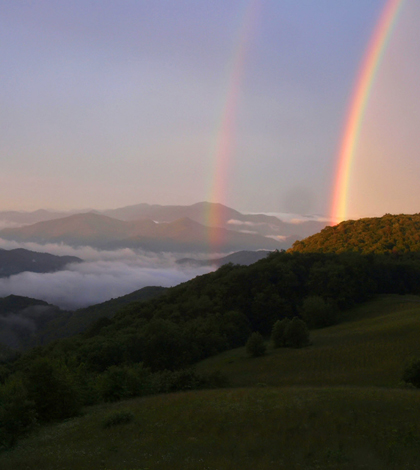National Park Service web cams capture more than just data

Double rainbow captured from Purchase Knob webcam at Great Smoky Mountains National Park
Since the U.S. National Park Service was established in 1916, part of the agency’s mission has been to increase Americans’ appreciation of nature’s wonder. Key to that effort – and also abiding by environmental regulations – is clean air and high visibility.
To achieve cleaner air, comply with the Clean Air Act and make sure parks are as close to natural conditions as possible, many national parks have air monitoring systems and webcams. But only 18 are part of the National Park Service’s air quality webcam network. Each camera updates every 15 minutes, giving clues to long-distance visibility. Coupled with weather sensors collecting data on ozone, particulate matter or encroaching weather systems, the webcams give a qualitative view on factors most often represented in numerical form.
“We want to engage people,” said Melanie Peters, natural resource specialist for the National Park Service. “To keep people connected remotely. If they can’t get there in person, to stay connected to the parks they love.”
Among the parks covered by the webcam network are Yosemite, Grand Canyon and Theodore Roosevelt. The network of webcams grants 24/7 access to online visitors. Great Smoky Mountains National Park has two webcams, both of which were in the top three for views in 2012. The cameras at Purchase Knob and Look Rock both had over a million views that year.
“Our mission is to preserve and protect our heritage, natural resources, unimpaired for future generations,” said Jim Renfro, air quality specialist at Great Smoky Mountains National Park. “And that goes for battlefields, parks, whatever it may be.”

A volcanic plume rises from the Halema’uma’u crater in Hawaii Volcanoes National Park, Hawaii as seen from the NPS air quality webcam at the volcano house overlook in the park.
Renfro says that the National Park Service is to be an adviser to the states, to help them abide by relevant mandates that exist for increasing the quality of water and air in their jurisdictions. Monitoring is key to that mission, so his station of weather sensors and webcams makes an important contribution.
“The idea initially was to take long range, qualitative views of visibility over a long distance,” said Peters. The idea grew into a sophisticated network, with Renfro managing the air quality sensors at Great Smoky.
Parameters collected by the station include ozone, particulate matter, temperature, humidity, wind and precipitation. “It’s a great outdoor lab, representative of the southeast regions of the Appalachian area,” said Renfro.

Air quality specialist Jim Renfro checks on visibility monitoring equipment atop the Look Rock air quality station in Great Smoky Mountains National Park, Tennessee.
Great Smoky is over 520,000 acres, and Renfro says his team can’t measure everywhere all the time. But there are a lot of other things that they track, like acid deposition from rain. Stations in mountainous regions collect statistics on solar radiation, rainfall and other climatic information over the long term to see how different elevations interact to impact air quality.
But webcams capture things that environmental sensors don’t.
“The cameras have captured wildfires at Yosemite, smoke from fires at Grand Canyon, rainbows, dust clouds,” said Peters. “We make sure to catch the dust on our filters. It’s not a park by park decision. It’s all done as part of national monitoring.”
Data on ozone, which are collected at 15 of the webcam sites, contributes to two different U.S. Environmental Protection Agency programs: the Clean Air Status and Trends Network (CASTNET) and the Air Quality System (AQS). Particulate monitoring is part of the Interagency Monitoring of Protected Visual Environments (IMPROVE) program.

Summer clouds move over the Teton range in Grand Teton National Park, Wyoming as captured by an NPS air quality webcam at the Teton Science School.
Peters says all the data undergo quality control checks before they can be added to any network. The process can be a long one. The most recent report for air quality in national parks spans the years 2000 to 2009. The findings?
“Visibility has been improving, but there are still some areas of significant concern,” said Peters. “Of those, most are getting better.”

Top image: Double rainbows are captured by the NPS air quality webcam at Purchase Knob in western North Carolina following a summer storm at Great Smoky Mountains National Park. (All photos: U.S. National Park Service)




0 comments